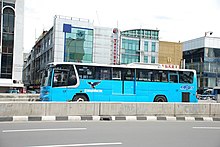TransJakarta
TransJakarta (stylised as transjakarta) is a bus rapid transit (BRT) system in Jakarta, Indonesia. The first BRT system in Southeast Asia, it commenced operations on 15 January 2004 to provide a fast public transport system to help reduce rush hour traffic. The system is considered as the first revolutionary public transit mode in the capital city of Indonesia.[5] The buses run in dedicated lanes, and ticket prices are subsidised by the regional government. TransJakarta has the world's longest BRT system (251.2 km in length),[6][4] which operates about 3900 buses. As of February 2020, it serves an average of 1.006 million passengers daily.[7]
TransJakarta logo | |
| Overview | |
|---|---|
| Locale | Jakarta, Indonesia |
| Transit type | Bus rapid transit |
| Number of lines | 13 BRT[1] (2 planned) 11 BRT express 25 city bus (integrated to BRT) 10 suburban bus 8 low cost apartment feeder |
| Number of stations | 241 |
| Daily ridership | 1.006 million/day (2020)[2] |
| Annual ridership | 264.61 million (2019)[3] |
| Website | www.transjakarta.co.id |
| Operation | |
| Began operation | 15 January 2004 |
| Operator(s) | see below |
| Technical | |
| System length | 251.2 kilometres (156.1 mi)[4] [1] |
History and development
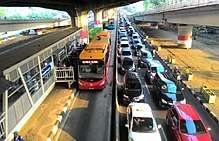
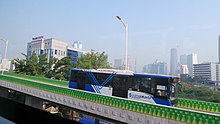
TransJakarta was built to provide a fast, comfortable, and affordable mass transportation system. To accomplish those objectives, the buses were given lanes restricted to other traffic and separated by concrete blocks on the streets that became part of the busway routes. The first TransJakarta line opened to the public on 15 January 2004.[8][9] It was free for the first two weeks, after which commercial operations started on 1 February 2004.
At present TransJakarta has 13 primary routes and ten cross-corridor routes.[1] In addition, there are 18 "feeder" routes that serve beyond the exclusive busway corridors to serve satellite cities in Greater Jakarta. TransJakarta has a total of 155 routes as of January 2019 (corridor, cross route, and feeder route), a significant increase from 41 in 2015.[10] The number of TransJakarta buses has also increased dramatically, from 605 buses in 2015 to 1500 in 2017, and plans to double that number.[11] The fare has remained Rp 3,500 (27 US cents) per passenger since operations began.[12] The service set a record in 2018 when it carried 730,000 passengers per day, a significant jump from 331,000 per day in 2015.[13] About 189.8 million passengers used TransJakarta in 2018 and targeted to serve one million passengers daily.[14]
As of September 2019, Transjakarta is currently testing electric buses,[15][16] with Bundaran Senayan – Monas as its first route.[17]
Operations
TransJakarta operates from 5:00 am to 11:00 pm. As of March 2020, Transjakarta operates in 248 routes. Seven routes have limited overnight services providing 24-hour operation.
Characteristics
The characteristics of TransJakarta listed in an Asian Development Bank study are:[18]
- Closed Trunk System without a Feeder System
- Elevated Platform for Rapid Boarding and Alighting
- Public Sector Bus Procurement and Private Sector Bus Operation
- Operating at 450,000 passengers/day (2016)
Routes
When TransJakarta commenced in 2004, 15 corridors were planned, and 13 are now operational. In 2017, the newest corridor opened. It is the first elevated corridor on the TransJakarta network.[19] Two more corridors are in the planning stages. Corridors 14, and 15 are designed to be a grade-separated elevated BRT line. TransJakarta BRT network is connected with KRL Commuter Jabodetabek and Jakarta MRT in Corridor 13, which was set to be completed in 2016.[20]
Other than main BRT routes, TransJakarta operates 11 BRT express routes (shortened version of the regular BRT routes), 25 city bus routes integrated to BRT stations, ten suburban routes to satellite cities, and eight routes serving low-cost apartments.[21]
| Corridor # | Origin-Destination | Opened | BRT Standard[22] |
|---|---|---|---|
| Kota - Blok M | 15 January 2004 | Silver | |
| Pulo Gadung - Harmoni | 15 January 2006 | Bronze | |
| Kalideres - Pasar Baru | 15 January 2006 | Bronze | |
| Pulo Gadung - Tosari | 27 January 2007 | Bronze | |
| Ancol - Kampung Melayu | 27 January 2007 | Bronze | |
| Dukuh Atas 2 - Ragunan | 27 January 2007 | Bronze | |
| Kampung Melayu - Kampung Rambutan | 27 January 2007 | Basic BRT | |
| Lebak Bulus - Harmoni | 21 February 2009 | Basic BRT | |
| Pluit - Pinang Ranti | 31 December 2010 | Basic BRT | |
| Tanjung Priok - PGC 2 | 31 December 2010 | Basic BRT | |
| Kampung Melayu - Pulo Gebang | 28 December 2011 | Basic BRT | |
| Penjaringan - Tanjung Priok[23][24] | 14 February 2013 | Basic BRT | |
| Ciledug - Tendean - Blok M | 14 August 2017 | (TBC) | |
| Blok M - Pondok Kelapa | (planned) | (TBC) | |
| Manggarai - Depok | (planned) | (TBC) |

In addition to the 15 main corridors, TransJakarta, in cooperation with other public transportation companies, provides feeder buses to passengers from suburbs outside Jakarta to bus termini.
Timeline of routes
- 15 January 2004: Corridor 1, (Blok M to Kota) (soft launch)
- 1 February 2004: Corridor 1, (Blok M to Kota) (commercial service)
- 15 January 2006: Corridor 2, (Pulo Gadung to Harmoni) and Corridor 3, (Kalideres to Pasar Baru) opened
- 27 January 2007: Corridor 4, (Pulo Gadung to Dukuh Atas 2), Corridor 5, (Kp. Melayu to Ancol), Corridor 6, (Halimun to Ragunan) and Corridor 7, (Kampung Rambutan to Kampung Melayu) opened
- 21 February 2009: Corridor 8, (Lebak Bulus to Harmoni) opened
- 31 December 2010: Corridor 9, (Pluit to Pinang Ranti) and Corridor 10, (PGC Cililitan to Tanjung Priok) opened.
- 18 March 2011: Corridor 9 was the only corridor serving until 11.00 pm. Followed by Corridor 1, with transit point with Corridor 9 at Semanggi shelter. The night service, however, stops only at certain shelters.[25][26]
- 20 May 2011: Corridor 2 and Corridor 3 initialised to serve until 11.00 pm, but only open nine shelters out of 22 on Corridor 2 and 9 out of 13 shelters on Corridor 3 remain open during the extended hours.[27]
- 1 July 2011: Corridors 4 to 7 began their late night-service, leaving only Corridor 8 without a late-night service.[28]
- 28 September 2011: Three feeder bus routes launched with Route 1 from West Jakarta Municipal Office to Daan Mogot, Route 2 from Tanah Abang to Medan Merdeka Selatan and Route 3 from SCBD to Senayan. The fare will be Rp.6,500 ($0.72), which cover tickets both for the feeder service and for TransJakarta buses. However, the feeder routes were eventually shut down because of the low number of riders.[29]
- 13 December 2011: Transjakarta began to separate male and female passengers, in which the commuter rail network has already done the separation earlier. The women-only areas are located between the middle door and driver cabins.
- 28 December 2011: Corridor 11 (Kp. Melayu to Pulo Gebang) opened.
- 14 February 2013: Corridor 12 (Pluit to Tanjung Priok) opened.
- 19 May 2014: The extension of Corridor 2 (Pulo Gadung to Harapan Indah) opened.
- 16 August 2017: Corridor 13 (Ciledug to Tendean) opened.
On 1 June 2014, a 24-hour operation began on three corridors – the Blok M-Kota route (Corridor 1), Pinang Ranti-Pluit route (Corridor 9) and Kalideres-Pasar Baru route (Corridor 3). Service is provided by 18 buses with two buses in reserve and the service frequency is between thirty minutes and an hour.[30][31] On 6 May 2015, 24-hour operation began on four corridors – the Harmoni-Pulogadung route (Corridor 2), Cililitan-Ancol Route (Corridor 5), Harmoni-Lebak Bulus route (corridor 8) and Tanjung Priok-Cililitan route (corridor 10). Service is provided by 28 buses with two buses in reserve and a 30- to 60-minute frequency.[32]
Fleet
Each bus is constructed with passenger safety in mind. For example, the body frame is constructed using Galvanyl (Zn–Fe Alloy), a strong and rust-resistant metal. There are also eight or ten glass-shattering hammers mounted on some of the window frames, and three emergency doors for fast evacuation during an emergency. There are also two fire extinguishers at the front and back of the buses.
Current fleet
A standard bus is painted with blue and white livery with the new TransJakarta logo. Regulations used to prohibit the use of diesel powered buses and obliged the use of CNG. However, due to efficiency issues and the limited number of CNG refueling stations, the use of diesel buses is permitted again.[33] Buses are equipped with two doors on each side to improve passenger flow in and out of the bus. Aside from that, the driver and passengers are divided by a partition to give the driver more concentration while driving on the road.
The capacity of each bus varies from 85, 100 to 120 passengers. Single Mercedes-Benz and Hino buses can carry about 85 passengers. Scania, Mercedes-Benz and Volvo Maxi buses can carry 100 passengers, and 120 can be carried by a standard articulated bus. TransJakarta operates Chinese-made Yutong, Zhongtong & Ankai and Swedish-made Scania articulated buses on long and straight corridors.[34]
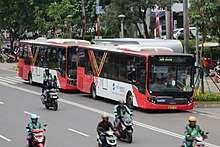
The passenger doors are higher than on ordinary buses so passengers can board only from designated shelters. The doors employ automated swing and slide mechanisms which are manually controlled by the driver. Currently, the slide mechanism is being phased out, with all new buses being equipped with swing doors. Protective full-height acrylic glass barriers are installed behind passenger seats close to the sliding door mechanism. Although, feeder routes use low street-level doors. This is achieved with the driver's door at the front-left side of the bus on big buses and a pair of a designated hydraulic folding door on medium buses.

Buses have their seats facing front, which is to reduce sexual harassment that usually happens in public transportation in rush hours. Each bus is equipped with an electronic board and speakers that announce the name of shelters in Indonesian and English. Each bus is also equipped with a bi-directional radio transceiver to allow the driver to provide and receive updated information regarding traffic jams, road accidents or lost items. CCTV cameras are a mandatory facility. Each bus is equipped with four CCTV cameras at the minimum. To keep the air fresh, especially during rush hours each bus is equipped with automatic air freshener dispensers which periodically spray car fragrance.
TransJakarta operates Royal Trans as a premium service. Premium seating are mounted in these units. Extra facilities includes extra comfort, free Wi-Fi, USB charging port and an onboard entertainment TV. No passenger are allowed to stand up. Payment is done in the buses with electronic tapping equipment. The service is not integrated to the main BRT system. Aside from that, TransJakarta also operates Metro Trans, which is a service not integrated to the BRT service. This service uses low entry buses. Integration from Metro Trans is possible at terminus such as Blok M and Pasar Kebayoran Lama.
In order to promote gender equity, TransJakarta is increasing the number of female driver recruits. The projected proportion is 30% of the total. Starting 21 April 2016, TransJakarta launched several new female-only buses for Corridor 1.[35] The bus is crewed by a female driver and female onboard officers and is painted pink to distinguish it from regular buses. TransJakarta has disabled-friendly buses on few routes. It will collect 300 more disabled-friendly buses within 2017 to operate in 15-20 routes.[36]

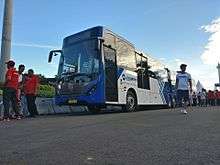
- Perum DAMRI
Zhongtong Bus LCK6180GC Doosan CNG Euro V - PT Transportasi Jakarta (Self Managed)
Yutong ZK6180HGC Weichai CNG Euro III, Ankai HFF6180G02D Weichai CNG Euro IV, Hino RK8JSKA-NHJ R260 (Night buses only), Zhongtong Bus LCK6180GC Doosan CNG Euro V, Scania K340IA CNG Euro VI, Scania K320IA CNG Euro VI, Mercedes Benz OH1526 NG M/T, Mercedes Benz OC 500 RF 2542, Mercedes Benz OH1626 A/T, Mercedes Benz OH1626 M/T, Hino RK1 JSNL-RHJ CNG Euro IV, Mercedes-Benz O500U 1726 and Scania K250UB 4x2 Euro III as Metro Trans, Mercedes-Benz OF 917 RF as Royal Trans - Perum PPD (Pengangkutan Penumpang Djakarta)
Hino RK8JSKA-NHJ R260, Zhongtong LCK6180GC Doosan CNG Euro V - Kopaja (Koperasi Angkutan Jakarta)
Toyota Dyna 110FT, Isuzu NQR 71, Isuzu FRR 90 - PT. Mayasari Bakti
Scania K320IA CNG Euro VI, Scania K310IB 6x2, Mercedes-Benz OH1626 A/T - Trans Swadaya
Mitsubishi FE 84G BC as Mini Trans - PT. Pahala Kencana
Mercedes-Benz OH1626 M/T - PT. Steady Safe Tbk
Volvo B11R - PT. Bianglala Metropolitan
Hino RK8JSKA-NHJ R260 as AMARI/ANDINI (Night Bus)
Future fleet
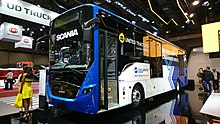
- PT. Transportasi Jakarta
MAB MD12E Electric bus and BYD K9 Electric bus - PT. Mayasari Bakti
Mercedes-Benz OH1626 A/T and Scania K250IB 4x2 Euro III - Kopami Jaya (Koperasi Pengemudi Angkutan Mikrobus DKI Jakarta)
Isuzu NQR71 as Mini Trans - PT. Bayu Holong Persada
Hino RN8JSKA-SJJ R285 - PT. Bianglala Metropolitan
Mercedes-Benz OH1626 A/T - PT. Metro Mini
Isuzu NQR71 as Mini Trans - Kopaja (Koperasi Angkutan Jakarta)
Mitsubishi FE 84G BC as Mini Trans - Koantas Bima (Koperasi Angkutan Lintas Bis Madya)
Hino FB 130 as Mini Trans
Note :During the Busworld South East Asia 2019, TransJakarta displayed two Electric buses, which are MAB MD12E and BYD K9 labeled as KalpaTrans.[38]
Retired fleet

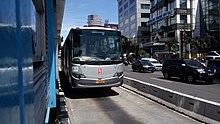
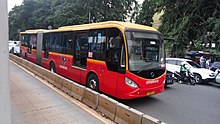
The Mercedes-Benz OH and Hino RG air-conditioned buses operated in Corridor 1 are painted red and yellow, with a picture of a young brahminy kite, which looks similar to a bald eagle grasping a tree branch with three salaks on it. The buses use special fuel which is (a mix of diesel and biodiesel). For Corridors 2 (bus colours: blue and white) and 3 (bus colours: yellow and red), the buses are CNG-fueled Daewoo buses imported from South Korea. Corridors 4, 5 and 6 used Grey Daewoo and Hyundai CNG buses, with Komodo and Huanghai articulated buses dedicated for Corridor 5. Grey Hino CNG buses are used for Corridors 7 and 8. Corridors 9 and 10 used Red coloured Hyundai and Komodo articulated buses, whilst Corridor 11 uses red Inobus articulated buses. Corridor 12 used to use red coloured Ankai and Inobus buses as well. Due to various coach builders being involved and design tweaks applied over time, the exterior and interior appearance, quality, and comfort varies between buses operating in the same corridor. Seats in old buses face the aisle to optimise passengers' movement during rush hours. Older buses were equipped with folding or hydraulic sliding doors, while newer units were equipped with swing doors.
In August 2011, TransJakarta operator installed cameras on one bus for a trial period. The plan is to install four cameras on each bus gradually in efforts to improve services such as to inform passengers waiting for buses about how crowded approaching buses are, and to prevent sexual harassment.[39]
- PT. Jakarta Express Trans
Hino RG J08C-TI and Mercedes-Benz OH1521 Intercooler OM366LA - PT. Trans Batavia
Daewoo BH115E Doosan Infracore GE12TI and Hino RK1 JSNL-RHJ CNG Euro IV - PT. Jakarta Mega Trans
Daewoo BH115E Doosan Infracore GE12TI, Hyundai Aero-Hi Class C6AC, Huanghai DD6181S01 Cummins ISL G 320 and AAI Komodo Doosan Infracore GE12TI - PT. Jakarta Trans Metropolitan
Daewoo BH115E Doosan Infracore GE12TI, Hyundai Aero-Hi Class C6AC and Hino RK8JSKA-NHJ R260 - PT. Eka Sari Lorena
Hino RK1 JSNL-RHJ CNG Euro IV and AAI Komodo Doosan Infracore GE12TI - PT. Primajasa Perdanarayautama
Hino RK1 JSNL-RHJ CNG Euro IV - PT. Bianglala Metropolitan
Hyundai Aero Class C6AC, AAI Komodo Doosan Infracore GE12TI, INKA Inobus Cummins ATC 320 CNG Series Euro V, Ankai HFF6180G02D Weichai CNG Euro IV, Hino RG J08C-TI and Mercedes-Benz OH1521 Intercooler OM366LA - PT. Trans Mayapada Busway
Hyundai Aero Class C6AC and AAI Komodo Doosan Infracore GE12TI - Perum DAMRI
INKA Inobus Cummins ATC 320 CNG Series Euro V
Shelters
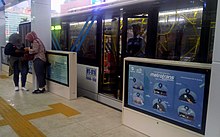
TransJakarta shelters are different from ordinary bus stops. They are usually located in the middle of the road and are reached by elevated bridges. Some stops are equipped with an escalator or lift and designed to be integrated into nearby buildings. For example, Tosari ICBC stop is connected directly to the UOB Plaza, and Blok M stop is connected directly into Blok M Mall via stair access.
The shelters are made from aluminium, steel, and glass. Air ventilation works through fins on the aluminium part of the shelters. Floors are made from tread plate, although newer shelters now use concrete. The shelters are equipped with platform screen doors. Some of the connecting elevated bridge ramps have gentle slopes (with some exceptions) to accommodate the disabled. One disadvantage of some of the ramps is that passengers need to walk a relatively long way up the ramps and then double back to reach the boarding shelters. The floors of the bridge are mostly treading plates, although some are made from concrete. One problem with the tread plate is that considerable noise is generated by the movement of passengers across the tread plate surfaces. Another problem is that some of the tread plate surfaces can become slippery during the rainy season. There are no sanitary facilities in most of the shelters.
Initially, bus stops are open from 05:00 am to 10:00 pm although opening hours can be extended if there are passengers still waiting at closing time. Since midnight bus services are launched, a number of shelters start to operate 24 hours a day.[40] Currently all bus stops serves round-the-clock. Shelters often become extremely overcrowded because of long and sometimes unpredictable intervals between buses. According to a report from the Indonesian Consumers Protection Foundation in 2011, the most common complaint from passengers about the service offered by Transjakarta was the long wait times for buses at some of the main shelters.[41]
The large Harmoni Central Busway (HCB) shelter on Jalan Gadjah Mada, Central Jakarta, is built over the Ciliwung River. It is a transit point between Corridors 1, 2, 3, 5C, 5H, 7F, 8, 8A, 9B and 10H. This 500-person shelter has 18 bus bays. Although many trees had to be sacrificed during the construction of it, an old banyan tree was not chopped down because it was considered rich in historical value. However, in October 2006 this tree was vandalised by people from the Pemuda Persatuan Islam religious group. Their motive was to show that the tree does not possess supernatural qualities.
Ticketing and fares
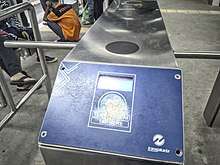
The cost of a TransJakarta ticket since its opening has been a flat rate of Rp 2.000,- at concessional times (05.00 a.m. to 07.00 a.m.) and Rp 3.500,- (about 24 US cents) at all other times.[12] Passengers who wish to change direction or transit to other corridors do not need to pay again, provided they do not exit the shelter. An exception is in effect at the line terminus.
Up to 2015, passengers could purchase a single-journey paper ticket at the ticket booth in the shelter. In 2013, TransJakarta introduced the use of prepaid cards or e-tickets from BRI BRizzi, BCA Flazz, BNI Tapcash, Mandiri E-Money, Bank DKI JakCard, and Bank Mega MegaCash. The prepaid cards can be purchased and topped-up at any ticket booth in the shelter throughout the system, or the ATM of the issuing bank. The e-ticket is priced at Rp 40,000, Rp 20,000 for the card itself and a balance of Rp 20,000.[42][43] The prepaid cards, except for Bank DKI JakCard and Bank Mega MegaCash, are also valid as a ticket in the Jabodetabek Commuter Train system as of June 2014, easing the integration plan between the BRT and the commuter train system.[44] In April and May 2014, the TransJakarta management started compulsory use of e-tickets at several terminus in the system, based on news that the BCA Flazz Card could also be used in Jabodetabek Commuter Train.[45] In mid-October 2014, 56% passengers have used e-tickets. Now, all TransJakarta corridors and shelters applied the compulsory use of the e-tickets, since 21 February 2015.[46] 17 August 2016 marks the start of tap-out system trial in Corridor 1 (Blok M - Kota),[47] while a similar trial was started on 9 September 2016 in Corridor 2. The system is meant to control the flow of people going in and out of the shelters, discourage illegal entrance to and exit from the shelters, and to encourage sales and usage of the "e-tickets". In October 2016, the system had been implemented in all corridors of TransJakarta.
Starting on 24 August 2015 students who have the Jakarta Smart Card (Kartu Jakarta Pintar, KJP) can use it as an e-ticket for a free bus ride.[48] The TJ Card, introduced in January 2018, provides free fares for their holders and is available for seniors above 60, residents of the Thousand Islands Regency, disabled persons, low-income households, teachers, mosquito controllers and mosque caretakers in addition to members of the Indonesian National Armed Forces and the Police.[49]
In feeder routes, passengers can pay cash to the bus conductor or use a prepaid card issued by a specific bank. This varies depending on the route (ex: Corridor 6H mainly accepts BCA Flazz cards only, Corridor 3E mainly accepts BNI Tapcash cards only), and is highly unreliable. The card-reading device is sometimes unavailable, or different to the usual bank device issued in one route. This method of payment is currently still in use and is gradually phased out in favor of the Tap-On-Bus (TOB) system. TOB acts similarly to the E-ticket payment system on shelters. It accepts payment from all prepaid bank-issued cards that are eligible on bus shelters. The only difference is that payment is done onboard the feeder bus instead of shelters. All buses assigned to routes 1H, 1N, 1R, 4F and 5F already has the TOB installed on it and make use of TOB for all payment.[50]
Passengers

During rush hours, people from upper or middle classes (one of the main targets of TransJakarta) usually prefer to use private cars or taxis to avoid the inconvenience of the overcrowded TransJakarta buses even though they have to bear with traffic jams instead. Many passengers are thus lower-middle-class people who are ex-users of other less comfortable and/or more expensive commercial buses. This situation is at odds with one of the objectives of TransJakarta, which was to reduce traffic jam during rush hours by persuading private car owners to use comfortable public transport.
There is a special program for the student groups called TransJakarta goes to school. Participants in the program are assigned a dedicated bus. The aim is to train students to stand in line, be decent, and prefer public transport than personal vehicles. The municipal government has been trying to encourage the population to shift from their private vehicles to public transportation, especially TransJakarta. Thus, several regulations are put in place to restrict private cars on the street. By August 2018, the odd–even traffic policy increases TransJakarta passengers by 30,000.[51]
Accidents and incidents
A number of design and operational problems have been identified. Despite having an exclusive bus lane, unauthorised vehicles illegally using the lanes in an attempt to more quickly navigate through the traffic jams are commonplace. Depot maintenance shops and special gas stations (most buses use compressed natural gas (CNG)) often have long lines of buses, restricting the availability of buses for service. The CNG powered buses also have suffered from higher fuel consumption than expected (one litre for 1.3 km compared to 2.1 km as specified) and high oil and moisture content requiring extra maintenance.[52] Other problems identified were: a lack of feeder bus services, a lack of adequate transfer information and transfer facilities and a lack of articulated buses.[53] A 2010 survey showed 75% of passengers transferred from medium or micro-buses to the TransJakarta buses, and it was estimated if direct service operations were implemented (i.e., multiple stopping points at some stations with bypass lanes and some services continuing beyond the trunk corridors) patronage would increase by 50%.[54] A feeder bus service called APTB was introduced in 2012.
In May 2013, it was reported the system was losing passengers due to unpredictable service frequency, worsening travel times and poor maintenance of the infrastructure and vehicles. The problem of excluding private vehicles from busway was ongoing.[55] By November 2013, after a campaign to "sterilise" the lanes improved travel times, reports indicate patronage had increased by 20,000 per day up to between 330,000 and 355,000.[56]
From January to July 2010, there were 237 accidents involving TransJakarta buses, resulting in 57 injuries and eight deaths. Accidents occurred due to pedestrians crossing the busway and cars making u-turns. In 2011, in an effort to stop non-TransJakarta vehicles using the bus lanes, the Jakarta Police Chief suggested that TransJakarta buses should run against the direction of traffic flow.[57] Usually, non-TransJakarta vehicles used the busway lanes during rush hours.[58]
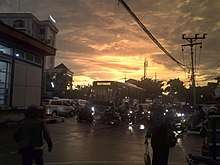
On 12 January 2012, a policeman from the Indonesian Police Headquarters, who was hired by Securicor, fired his gun near the ear of a TransJakarta officer, after threatening to kill him. The policeman was angry after the TransJakarta officer stopped the Securicor car from entering the busway lane, which allows only TransJakarta buses, ambulances and firefighter to enter. The police spokesman said that the policeman would be charged by criminal law or disciplinary sanction.[59][60][61]
Hijacking
On 12 March 2012, four TransJakarta buses were hijacked by alleged university students at the Medan Merdeka Selatan street. The buses were driven to the front of the Universitas Kristen Indonesia (Christian University of Indonesia) campus. Three drivers were able to escape from their buses, but one driver was prevented from leaving and forced to drive the hijackers to their destination. Fire extinguishers, glass-breaking hammers and drivers' jackets were also stolen from the buses.[62]
Bombing
On 24 May 2017, a twin bomb attack struck the Kampung Melayu Transjakarta bus terminal. The first explosion happened at nine sharp, near the terminal's toilet, and the second explosion happened five minutes after at the bus stop. In total, five people were killed, including the two suspects.[63]
Sexual harassment
A number of sexual harassment cases have been reported on board crammed TransJakarta buses and their overcrowded stations over the past few years, as the number of passengers has continued to rise.[64] TransJakarta responded by providing a women-only area at the front of its buses[65] and launching women-only buses.[66]
Logos
 2004-2012
2004-2012- 2012-2014
Transit Oriented Development
Seventeen Transit Oriented Development (TOD) is being built to integrate of multiple transport systems to facilitate easy and convenient transit between various mode of public transportation. At Tebet, the TOD integrates TransJakarta and the Commuter Line.[67] Meanwhile at Dukuh Atas Integrated Area (Indonesian: Kawasan Integrasi Dukuh Atas or KIDA), the aim is to prioritise walking and the use of public transport as a commuting solution, rather than using private vehicles.[68] KIDA will integrate seven transport systems in total, which are the Jakarta MRT, Jabodebek LRT, Jakarta LRT, Soekarno-Hatta Airport Rail Link, Commuter Line, TransJakarta, and other bus services.[69]
As of July 2019, there are about 1,170 Angkot micro-buses integrated with different routes of Transjakarta, which is expected to increase 1500 by the end of the year.[70]
See also
References
- Bambang Nurbianto (12 September 2015). "Train service has moved forward, can Transjakarta follow?". The Jakarta Post.
- "Achievement unlocked: Transjakarta breaks record for serving one million customers in a day". The Jakarta Post. Retrieved 8 April 2020.
- "Jumlah Penumpang Transjakarta Tahun 2018 Capai 189,77 Juta". KOMPAS (in Indonesian). 1 January 2019. Retrieved 1 January 2019.
- "Koridor". Transjakarta.
- "Revolutionary Transjakarta proves its relevance after 15 years". The Jakarta Post. Retrieved 15 January 2019.
- "Transjakarta – PT Transportasi Jakarta". transjakarta.co.id. Retrieved 2019-01-03.
- "Achievement unlocked: Transjakarta breaks record for serving one million customers in a day". The Jakarta Post. Retrieved 5 February 2020.
- "Sosialisasi Busway 15 Januari 2004". liputan6.com. 23 December 2003. Retrieved 20 May 2018.
- Rudi, Alsadad (15 January 2013). "15 Januari Genap 9 Tahun Transjakarta, Bagaimana Kini?". Kompas. Retrieved 20 May 2018.
- "Revolutionary Transjakarta proves its relevance after 15 years". The Jakarta Post. Retrieved 15 January 2019.
- Post, The Jakarta. "With more buses on the streets, a surge in Transjakarta passengers". The Jakarta Post.
- Callistasia Anggun Wijaya (4 January 2016). "Ahok to lower bus fares to attract Transjakarta passengers". The Jakarta Post.
- "Outlook: Jakarta eyes bright future for urban transportation in 2019". The Jakarta Post. Retrieved 22 February 2019.
- "Transjakarta Targets 231 Million Passengers in 2019". Tempo. Retrieved 2 January 2019.
- "Mei 2019, Transjakarta Uji Coba 10 Bus Listrik Ramah Lingkungan". KOMPAS.com (in Indonesian). Retrieved 2019-04-21.
- "Simak Jadwal Bus Listrik Transjakarta Mulai Beroperasi". KOMPAS.com (in Indonesian). Retrieved 2019-04-21.
- "Transjakarta Uji Coba Bus Listrik, Rute Pertama Bundaran Senayan – Monas". KOMPAS.com (in Indonesian). Retrieved 2019-04-21.
- "BRT – CASE STUDY 5 – Annex 5 Case Studies and Lessons – Module 2: Bus Rapid Transit (BRT): Toolkit for Feasibility Studies". Sti-india-uttoolkit.adb.org. Retrieved 2012-01-31.
- Media, Kompas Cyber. "Halte Mayestik dan Tirtayasa Koridor 13 Belum Dilengkapi Lift". KOMPAS.com.
- "Proyek Jalan Layang Transjakarta Dibangun". February 17, 2015.
- "Transjakarta Network Map". PT Transportasi Jakarta. Retrieved 15 March 2017.
- "Transjakarta Corridor 1 Achieved Silver Standard". Retrieved 2014-08-24.
- "Jokowi Resmikan TransJakarta & Transportasi Air". February 14, 2012.
- "36 Bus TransJ Siap Layani Koridor 12 Pluit - Tanjung Priok". February 14, 2013.
- 'Penumpang Busway Malam Hari Naik Terus', The Jakarta Post, 28 April 2011.
- "Transjakarta hours to be extended". The Jakarta Post. 2011-04-29. Retrieved 2012-01-31.
- "Commuters want better Transjakarta maintenance". The Jakarta Post. 2011-05-21. Retrieved 2012-01-31.
- "Busway operational hours extended". The Jakarta Post. Retrieved 2012-01-31.
- "Transjakarta feeder service begins today". September 28, 2011.
- "Jakartans welcome 24-hour Transjakarta services". Jakarta Post. June 2, 2014.
- http://www.transjakarta.co.id/news.php?id=plQ=
- http://transjakarta.co.id/news.php?id=qFE=
- Nibras Nada Nailufar (July 23, 2015). "Ini Alasan TransJakarta Beralih ke Bus Diesel". Tempo (in Indonesian). Retrieved July 8, 2020.
- Mengenal Ragam Bus TransJakarta Archived November 30, 2010, at the Wayback Machine
- Silaban, Martha Warta (April 21, 2016). "Transjakarta Khusus Wanita Beroperasi Mulai Hari Ini". Tempo.
- Post, The Jakarta. "300 disabled-friendly buses ready to serve Jakartans this year". The Jakarta Post.
- "Informasi Armada Bus Transjakarta (diurut dari operator terlama)". busway fans club. 2014-03-22. Retrieved 2015-03-17.
- "Transjakarta Pajang 2 Bus Listrik di Pameran Busworld South East Asia 2019". Tribun News. 2019-03-20. Retrieved 2019-03-24.
- "Busway soon to be equipped with cameras". August 24, 2011.
- Atmi Pertiwi (June 1, 2014). "Mulai Hari Ini Transjakarta 24 Jam di Tiga Koridor". Tempo. Retrieved June 23, 2020.
- Novia E. Ruslistia (December 22, 2011). "Complaints went unheeded in 2011, YLKI tells Transjakarta". The Jakarta Post.
- "Apa Beda e-Ticket Transjakarta dengan KRL". Retrieved August 18, 2014.
- Duwi Setiya Ariyanti. "E-CARD TRANSJAKARTA: Saldo Tiket Elektronik Bisa Diisi di Halte Busway". Retrieved August 18, 2014.
- "Tiket dan Tarif".
- "E-Ticket Transjakarta Bikin Ribet". April 22, 2014.
- "56 Persen Penumpang Transjakarta Sudah Gunakan E-Ticketing". October 23, 2014.
- http://transjakarta.co.id/tap-in-dan-tap-out-halte-transjakarta/
- "Free Bus Ride for KJP Holders". August 24, 2015.
- "Transjakarta free-ride card registration to open at mayor's offices". The Jakarta Post. January 31, 2018.
- Anastasia Aulia (6 August 2019). "Mesin Tap On Bus Sudah Terpasang di 100 Unit Transjakarta". Kompas (in Indonesian). Retrieved 22 June 2020.
- "Odd-Even Policy Increases Transjakarta Passengers by 30,000". Tempo. Retrieved 8 August 2018.
- http://www.uncrd.or.jp/content/documents/5EST-B2B4.pdf
- http://adbleadership.asia/resources/transport_sector_casestudy/Transport%20Sector%20Case%20Study_Jakarta%20BRT.pdf
- "Implementing Low Carbon Public Transportation-Direct Service Report 2012". ITDP Indonesia. Retrieved 2014-08-28.
- "Transjakarta could lose yet more passengers". Jakarta Post. May 8, 2013.
- "Transjakarta Passengers Increase After Sterilization". Tempo. 28 November 2013.
- "Jakarta welcomes plan to impose counter-flow lane for TransJakarta", The Jakarta Post, 2 October 2010, retrieved 2011-03-13
- "Busway struggles to provide decent service". The Jakarta Post. 2011-05-13. Retrieved 2012-01-31.
- "Petugas Transjakarta Diancam Pakai Senjata". January 12, 2012.
- "Polisi Tembak Petugas Jaga Jalur Transjakarta". January 12, 2012.
- "Oknum Polisi Penembak Petugas "Busway" Dinas di Mabes". January 13, 2012.
- "Mahasiswa Pembajak Transjakarta Curi Perlengkapan Bus". Retrieved March 2, 2012.
- "Ledakan Kampung Melayu, Polisi dan Sopir Luka Parah". May 24, 2017.
- "Another Alleged Sexual Harassment at TransJakarta Station". December 5, 2012.
- "Transjakarta Sediakan Area Khusus Perempuan". December 12, 2011.
- "'Bus Khusus Wanita' Transjakarta Menuai Kritik". December 27, 2016.
- Heldania Ultri Lubis (July 23, 2017). "Ini 17 Stasiun yang akan Terintegrasi TransJ".
- Arief Ikhsanudin (April 30, 2019). "Anies Resmikan Kawasan Integrasi Transportasi Dukuh Atas".
- Nibras Nada Nailufar (April 30, 2019). Dian Maharani (ed.). "Integrasi di Dukuh Atas Dilewati Tujuh Transportasi, dari KRL, LRT, hingga MRT".
- "29 New Jak Lingko Routes Integrated with Transjakarta Bus". Tempo. Retrieved 22 July 2019.
External links
| Wikimedia Commons has media related to TransJakarta. |
- (in Indonesian) Official website
- (in Indonesian) Transjakarta Community Site
- (in Indonesian) Transjakarta map
- (in Indonesian) Transjakarta Guide for Blackberry (Download)
- (in Indonesian) Interactive Transjakarta Map and Shelters Info
